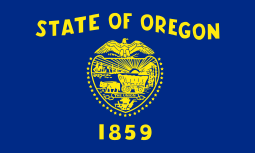Conde McCullough Memorial Bridge
| Coos Bay Bridge | |
|---|---|
 | |
| Coordinates | 43°25′51″N 124°13′20″W / 43.43072°N 124.222336°WCoordinates: 43°25′51″N 124°13′20″W / 43.43072°N 124.222336°W |
| Carries |
|
| Crosses | Coos Bay |
| Locale | North Bend, Oregon |
| Official name | Conde B. McCullough Memorial Bridge |
| Maintained by | Oregon DOT |
| Characteristics | |
| Design | Cantilever through-truss |
| Total length | 5,305 ft (1,617.0 m) |
| Longest span | 793 ft (241.7 m) |
| Clearance below | 150 ft (45.7 m) |
| History | |
| Opened | 1936 |
|
Coos Bay Bridge No. 01823 | |
| Built | 1934–36[1] |
|---|---|
| MPS | McCullough, C.B., Major Oregon Coast Highway Bridges, 1927-1936 |
| NRHP Reference # | 05000817[1] |
| Added to NRHP | August 5, 2005[1] |
The Conde B. McCullough Memorial Bridge, formerly the Coos Bay Bridge (Coos language: Danisich[2]), is a cantilever bridge that spans Coos Bay on U.S. Route 101 near North Bend, Oregon. It is one of a series of eleven major bridges on the Oregon Coast Highway that were designed under the supervision of Conde B. McCullough, replacing ferries that had formerly crossed the bay. The bridge is outstanding for its attention to form and detail, and has been placed on the National Register of Historic Places in recognition of its design and cultural and economic importance.
History

Work started on what was then called the Coos Bay Bridge on July 10, 1934. Glenn S. Paxson, Acting State Bridge Engineer while McCullough took a leave of absence to work on projects in Central America, was the supervising engineer during construction. The resident engineer was Raymond Archibald until 1935, when he joined McCullough, then Dexter R. Smith. The Northwest Roads Company of Portland, Oregon built the piers and the concrete structure. The steel sections of the bridge were built by the Virginia Bridge and Iron Company. The main piers are supported on piles driven into the bay's bed. The main towers of the cantilever section were fabricated off-site and moved to the bridge site in four sections. Work on the cantilever arms moved out in both directions from the tower, with the shoreward arm keeping slightly ahead of the center arm so that it would rest on a temporary support structure to stabilize the bridge. The concrete arch sections were erected using timber falsework. The bridge opened in June 1936.[1]
When the bridge was completed in 1936 it was the longest bridge in Oregon.[3] It was the costliest of the Oregon Coast bridges at $2.14 million (equivalent to approximately $35 million in 2012[4]). Because the five largest bridges on the coastal route were so expensive, their construction was largely funded by the Public Works Administration. The Coos Bay Bridge was dedicated to its designer, Conde McCullough, in 1947.[1]
The McCullough Bridge was damaged on December 4, 1986 when a Swedish ship, the Elgaren, struck the bottom of the center span. The ship was entering the harbor on a day when the tide was 3 feet (0.91 m) above normal, and was unable to lower a vertically-stowed ramp in time after the ramp's mechanism malfunctioned. The bridge was closed for repairs.[1]
Description
Because of the long spans and heavily trafficked shipping channel, a cantilever construction was deemed most suitable; a draw span was rejected because it would have to be opened too often. Consequently the 793-foot (242 m) main span has 145 feet (44 m) of vertical clearance and is part of a 1,708-foot (521 m) long steel cantilever span. Overall length, including the concrete approach spans is 5,305 feet (1,617 m). The approach spans are concrete arches more typical of McCullough's designs.[5] The main roadway is 27 feet (8.2 m) wide with 3.5-foot (1.1 m) wide sidewalks on either side. The main towers rise 280 feet (85 m) above the water surface, with curved sway bracing in a Gothic arch style. The open-spandrel concrete approach arches vary in span from 265 feet (81 m) to 151 feet (46 m). The ends of the bridge are marked by pedestrian plazas meant to provide a viewing point for the bridge and to provide access to the shoreline. These plazas are detailed with Art Moderne motifs and are provided with built-in benches. The stairs are descend in sweeping curves to the park below.[1]
Designation
The city of North Bend, Oregon uses images of the bridge extensively in public relations material. The bridge was placed on the National Register of Historic Places on August 5, 2005.[1]
See also
-
 Bridges portal
Bridges portal -
 Oregon portal
Oregon portal - List of bridges on U.S. Route 101 in Oregon
- List of bridges on the National Register of Historic Places in Oregon
References
- 1 2 3 4 5 6 7 8 Hadlow, Robert W. (June 30, 2004). "National Register of Historic Places Registration Form: Coos Bay Bridge No. 01823/Conde B. McCullough Memorial Bridge" (PDF). National Park Service. Retrieved February 4, 2012.
- ↑ "Hanis for Beginners" (PDF). Confederated Tribes of Coos, Lower Umpqua and Siuslaw Indians. 2001. Retrieved April 6, 2014.
- ↑ Smith, Dwight A.; Norman, James B.; Dykman, Pieter T. (1989). Historic Highway Bridges of Oregon. Oregon Historical Society Press. p. 82. ISBN 0-87595-205-4.
- ↑ Inflation Calculator
- ↑ Hadlow, Robert W. (2001). Elegant Arches, Soaring Spans: C.B. McCullough, Oregon's Master Bridge Builder. Oregon State University Press. pp. 106–109. ISBN 0-87071-534-8.
External links
![]() Media related to Conde McCullough Memorial Bridge at Wikimedia Commons
Media related to Conde McCullough Memorial Bridge at Wikimedia Commons
- Historic American Engineering Record (HAER) No. OR-46, "Coos Bay Bridge, Spanning Coos Bay on Oregon Coast Highway, North Bend, Coos County, OR", 32 photos, 1 color transparency, 10 data pages, 4 photo caption pages
- ODOT
- Bridgemeister.com
- McCullough Memorial Bridge at Structurae
- Coos-Bay.net